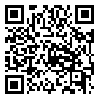Volume 11, Issue 3 (September 2024)
Avicenna J Neuro Psycho Physiology 2024, 11(3): 102-107 |
Back to browse issues page
Ethics code: IR.IAU.BIRJAND.REC.1403
Download citation:
BibTeX | RIS | EndNote | Medlars | ProCite | Reference Manager | RefWorks
Send citation to:



BibTeX | RIS | EndNote | Medlars | ProCite | Reference Manager | RefWorks
Send citation to:
Falahati V, PanahiShahri M, Sahebdel H. Comparing the Effectiveness of Reality Therapy and Acceptance and Commitment Therapy Programs in Reducing High-Risk Sexual Behaviors among Adolescents. Avicenna J Neuro Psycho Physiology 2024; 11 (3) :102-107
URL: http://ajnpp.umsha.ac.ir/article-1-484-en.html
URL: http://ajnpp.umsha.ac.ir/article-1-484-en.html
1- Department of Psychology, Qaenat Branch, Islamic Azad University, Qaenat, Iran
2- Faculty of Educational and Psychology, Department of Educational Sciences, Payame Noor University, Tehran, Iran ,mpanahishahri@gmail.com
3- Department of Counseling, Qaenat Branch, Islamic Azad University, Qaenat, Iran.
2- Faculty of Educational and Psychology, Department of Educational Sciences, Payame Noor University, Tehran, Iran ,
3- Department of Counseling, Qaenat Branch, Islamic Azad University, Qaenat, Iran.
Abstract: (2183 Views)
Background and Objective: This study aimed to compare the effectiveness of reality therapy (RT) and acceptance and commitment therapy (ACT) programs in reducing high-risk sexual behaviors (HRSBs) among adolescents.
Materials and Methods: This quasi-experimental study was conducted based on a pretest-posttest control group design. The statistical population comprised all male students at the upper secondary schools in the city of Ghaen, South Khorasan Province, Iran, in the 2022-2023 academic year. Among them, 45 individuals were selected by purposive sampling method and then randomized into three groups in line with the inclusion and exclusion criteria. Afterward, they completed the High-Risk Sexual Behaviors Scale (HRSBS) at the pretest and posttest stages. During the intervention programs, the experimental groups (EGs) I and II respectively received RT and ACT for eight 90-minute sessions, while the CG was only given daily training. To analyze the data, the SPSS Statistics (version 24) software package and the univariate analysis of covariance (ANCOVA) were utilized, considering the statistical assumptions.
Results: The study results revealed that the RT program significantly reduced HRSBs; however, ACT exhibited no noteworthy effects in this vein. Moreover, a significant difference was detected between the effectiveness of both interventions in lowering HRSBs (P<0.001).
Conclusions: The present study ultimately demonstrated that the RT program was a better and more efficient practice for adolescents, as compared to ACT. It further provided a greater opportunity for counselors and therapists to manage the major problems facing this age group.
Materials and Methods: This quasi-experimental study was conducted based on a pretest-posttest control group design. The statistical population comprised all male students at the upper secondary schools in the city of Ghaen, South Khorasan Province, Iran, in the 2022-2023 academic year. Among them, 45 individuals were selected by purposive sampling method and then randomized into three groups in line with the inclusion and exclusion criteria. Afterward, they completed the High-Risk Sexual Behaviors Scale (HRSBS) at the pretest and posttest stages. During the intervention programs, the experimental groups (EGs) I and II respectively received RT and ACT for eight 90-minute sessions, while the CG was only given daily training. To analyze the data, the SPSS Statistics (version 24) software package and the univariate analysis of covariance (ANCOVA) were utilized, considering the statistical assumptions.
Results: The study results revealed that the RT program significantly reduced HRSBs; however, ACT exhibited no noteworthy effects in this vein. Moreover, a significant difference was detected between the effectiveness of both interventions in lowering HRSBs (P<0.001).
Conclusions: The present study ultimately demonstrated that the RT program was a better and more efficient practice for adolescents, as compared to ACT. It further provided a greater opportunity for counselors and therapists to manage the major problems facing this age group.
Article Type: Research Article |
Subject:
Clinical Psychology
Received: 2024/04/30 | Accepted: 2024/11/9 | Published: 2025/02/24
Received: 2024/04/30 | Accepted: 2024/11/9 | Published: 2025/02/24
Send email to the article author
| Rights and permissions | |
 |
This work is licensed under a Creative Commons Attribution-NonCommercial 4.0 International License. |






